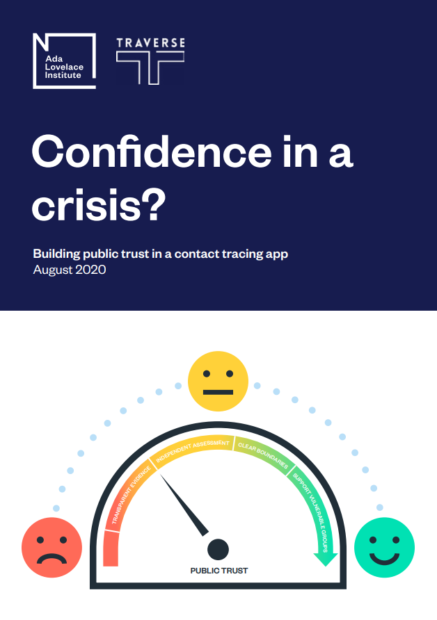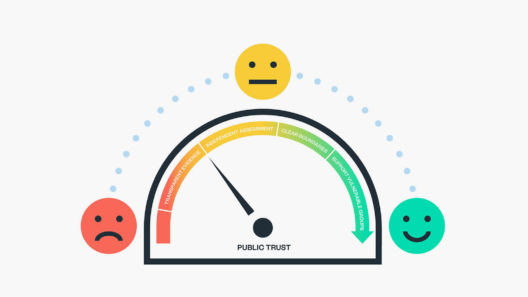Confidence in a crisis?
Building public trust in a contact tracing app
Findings of a public online deliberation project on attitudes to the use of COVID-19 related technologies for transitioning out of lockdown
17 August 2020

Confidence in a crisis? Building public trust in a contact tracing app presents the findings of an online deliberation project with 28 members of the public run during May and June 2020 by the Ada Lovelace Institute, Traverse, Involve and Bang the Table to explore attitudes to the use of COVID-19 related technologies for transitioning out of lockdown.
The project was deliberative, bringing together participants from a range of backgrounds. It provided participants with a space to discuss and understand different viewpoints, to learn about the subject matter and reflect on a variety of views as they formed their own opinions.
The core question posed to the cohort was:
‘Under what circumstances do citizens think that technological solutions like the COVID-19 contact tracing app are appropriate?’
Over three weeks the participants assessed the evidence, debated and deliberated on the requirements that would make a Government contact tracing app trusted and justified. Views evolved alongside the changing picture of the spread of the pandemic and the Government
response.
The deliberation took place at a unique moment – opening as the Government announced the trial of a contact tracing app on the Isle of Wight, running across the ‘Barnard Castle’ visit, and concluding as the death of George Floyd sparked global protests against racial injustice and evidence emerged of the disproportionate impact of the virus on Black, Asian and minority ethnic communities.
Yet the four strong steers from this mini public on how to build COVID-19 technologies with legitimacy remain pertinent to current concerns:
- Provide the public with a transparent evidence base. A lack of transparency, particularly the limited information about the first Isle of Wight trial, generated suspicion and distrust. The public would like to see clear and accessible evidence on whether technologies are effective, and under what conditions. People want to have confidence that lives would be saved and expect easily accessible information about aspects like the evolving health context or relationships with commercial providers
- Offer independent assessment and review of the technology. The question of who is making judgements is important to the public, and trust in decision-makers can be fragile. Trust can be strengthened with the inclusion of independent reviewers, assessors and evaluators to shape the development of the technology.
- Clarify boundaries on data use, rights and responsibilities. Wanting independent oversight doesn’t negate the desire for clarity on users’ data rights. It must be easy to know and clearly justify what data would be held, by whom, for what purpose, and for how long.
- Proactively address the needs of, and risks relating to, vulnerable groups. Support must be built in for people who may have additional vulnerabilities or be rendered vulnerable as a result of the pandemic. A public health technology must enable equal access and equal distribution of benefits; protect against the surveillance, or profiling of, different demographic groups; and ensure that new tools like immunity certificates do not become a gateway to privileges.
We publish these findings at a crucial junction for the next iteration of the NHS contact tracing app, as the Government begins the next pilot of the app.
Since the conclusion of this period of deliberation, the Government’s technical approach has shifted – namely the decision to discontinue the original centralised NHSX app in favour of an app developed using Google and Apple’s ‘decentralised’ exposure notification API. While this overcomes some technical issues, particularly registering iPhones that have the app running in the background, it also complicates the ability to accurately measure distance – a key issue that the NHSX team has been working on and will be testing in the pilot.
The function of the app is also evolving, with the Government more firmly integrating the app into the Test and Trace programme, and including in the first pilot features such as the ability to warn of local risk levels, scan QR (quick response) codes at venues people visit and order tests. Future versions may allow people to enter personal information to create an individual risk score, which could combine personal information with the Bluetooth measures of proximity.
Whatever functionality is adopted, the effectiveness of a contact tracing app, or other technologies, relies on mass adoption. This will require public trust and buy-in for the decisions made around the app, and the system it is part of. Having already had one false start, it’s important the next phase is done carefully and thoughtfully. Ignoring the public and getting this next stage wrong may do greater damage than one failed app. It risks undermining trust in the public health strategy and the Government’s management of the crisis.
At this crucial moment pre-roll out, drawing from the findings of this deliberation, as well as supporting research, we have developed a checklist for the Government, policymakers and tech developers grappling with this tricky next phase, which will help design and deliver COVID-19 technologies with public legitimacy built in.
Related content

Why algorithms aren’t the answer: what the public needs to trust technology
A ten-point checklist for the Test and Trace team working on contact tracing app 2.0, based on the findings of rapid online public deliberation.